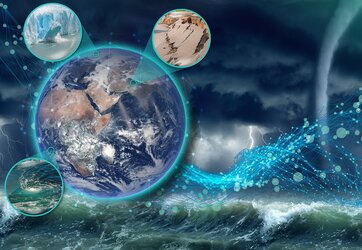Four mission ideas to compete for Earth Explorer 11
As part of ESA’s commitment to develop and build satellite missions that push the boundaries of satellite technology and Earth science, four new mission ideas – Cairt, Nitrosat, Seastar and Wivern – have been selected to enter pre-feasibility study and compete to be the eleventh Earth Explorer mission.
This important milestone follows a Call for Earth Explorer 11 mission ideas, which ESA released just over a year ago. Out of the 15 proposals submitted, ESA’s Advisory Committee for Earth Observation, ACEO, recommended that these four mission ideas should go forward for study.
Today, ESA’s Programme Board for Earth Observation accepted the Committee’s recommendation.
Our planet works as a complex system that involves considerable natural variability, but human activity is taking its toll on many of these natural processes. However, there remains much we don’t understand about the interactions that bind the Earth system as a whole.
Earth Explorers are built to demonstrate new space technology and provide answers to key scientific questions – not just for academic gain, but also to help address societal issues that humankind will face in the coming decades such as the availability of food, water, energy and resources, as well as health and climate change.
ESA’s Acting Director of Earth Observation, Toni-Tolker Nielsen, said, “Earth Explorers are Europe’s flagship research missions and are at the heart of our FutureEO programme. For those already launched, they all continue to return remarkable scientific results and, without exception, have all gone way beyond their original objectives. It is vital we continue developing, building and launching these exceptional missions to further knowledge and prove new technology. We are therefore thrilled to announce that Cairt, Nitrosat, Seastar and Wivern – are entering the pre-feasibility phase, eventually culminating in one being our eleventh Earth Explorer.”
Cairt – short for changing-atmosphere infrared tomography – would provide the measurements needed to make a necessary step change in understanding the links between climate change, atmospheric chemistry and dynamics in the altitude range of about 5 to 120 km. It would focus on the processes that couple atmospheric circulation, composition and regional climate change, providing critical observations not available from existing or planned satellite missions. Cairt would be the first limb-sounder with imaging Fourier-transform infrared technology in space.
Nitrosat would measure two of the most important reactive nitrogen compounds in the atmosphere, nitrogen dioxide (NO2) and ammonia (NH3), which are at the root of a wide range of environmental problems. Nitrogen dioxide is a harmful air pollutant and a precursor of ozone and particulate matter. Ammonia is not directly harmful for human health at ambient levels, but is a key precursor to formation of fine aerosol particle pollution. Both compounds are linked to climate change through interactions between the natural carbon and nitrogen cycles. The mission could therefore contribute to important societal applications and environmental policy.
Wivern – short for wind velocity radar nephoscope – is the only mission in the world that would measure wind in clouds, and deliver profiles of rain, snow and ice water. Carrying a dual-polarisation, conically scanning 94 GHz Doppler radar, the mission would benefit the prediction of high-impact weather and hazard warnings for weather forecast models and contribute to the climate record of cloud and precipitation profiling.
Seastar would provide ocean surface current and surface wind vectors at 1 km resolution for all the coastal ocean, shelf seas and marginal ice zones. This information would further answer scientific questions concerning ocean dynamics and small-scale ocean process, which are important for understanding air–sea interactions that are linked to primary productivity supporting the marine food chain. These small-scale dynamics are also important for the dispersion of oil and plastic pollution. The satellite would carry a two-antenna along-track interferometry radar.
Pre-feasibility studies will start in due course, after which further down-selections will be made in 2023 and 2025, with a view to launching the successful Earth Explorer 11 mission in 2031–2032.










